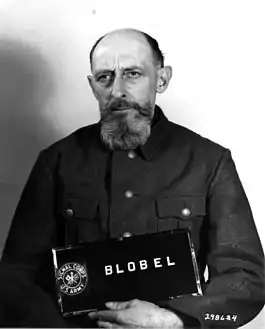زوندركوماندوس 1005
قالب:Infobox holocaust eventقالب:Infobox holocaust event زوندركوماندوس 1005 وتسمى أيضًا أكتون 1005، أو Enterdungsaktion ( (بالإنجليزية: Exhumation Action) Exhumation) بدأ في مايو 1942 أثناء الحرب العالمية الثانية لإخفاء أي دليل على أن أشخاصًا قد قُتلوا على يد ألمانيا أثناء قيام أكتيون راينهارد في بولندا التي احتلتها ألمانيا. استخدمت العملية، التي أجريت في سرية تامة من 1942-1944، السجناء لاستخراج المقابر الجماعية وحرق الجثث. تم تسمية مجموعات العمل هذه رسميًا باسم Leichenkommandos ("وحدات الجثث") وكانت جميعها جزءًا من ساندركوماندوس 1005؛ كان يتم وضع السجناء في كثير من الأحيان من أجل منع الهروب.
تم وضع المشروع من أجل تدمير أدلة الإبادة الجماعية التي ارتكبها أينزاتسغروبن، وفرق الموت النازية التي قتلت الملايين، بما في ذلك أكثر من مليون يهودي، والغجر والمدنيين السلاف المحليين. أشرف على أكتون فرق مختارة من الأس دي وأوربو.
العمليات
في مارس 1942، وضع إس إس - أوبر غروبن فوهرر راينهارد هايدريش راينهارد هايدريش إس إس- شتاندارتن فوهرر باول بلوبل المسؤول عن أكتون 1005، على الرغم من تأخر بدايتها بعد اغتيال هايدريش في يونيو 1942. بعد نهاية يونيو، أصدر SS- جروبنفهر هاينرش مولر، قائد الغيستابو، أوامر باول أخيرًا. في حين كان الهدف الرئيسي هو محو الأدلة على الإبادة اليهودية، فإن أكتيون سيشمل أيضًا الضحايا غير اليهود على يد أينزاتسغروبن. [1]
الأعقاب
في محاكمات نورمبرغ بعد الحرب العالمية الثانية، قدم نائب أدولف أيخمان، إس إس - هاوبستورمفيرهر ديتر ويسليكني الشهادة التالية بخصوص أكتيون 1005.

حكم على بلوبل بالإعدام من قبل محكمة نورمبرغ العسكرية الأمريكية في محاكمات أينزاتسغروبن. تم إعدامه في سجن لاندسبيرج في 8 يونيو 1951. يُعزى قرابة 60 ألف حالة وفاة إلى بلوبيل، رغم أنه زعم خلال شهادته في نورمبرج أنه قتل ما بين 10 آلاف و 15 ألف شخص فقط. [3]
حاول الادعاء في محاكمة أدولف أيخمان في عام 1961 إثبات أن أيخمان كان رئيسًا لبلوبيل، لكن المحكمة لم تقبله. [4]
ملاحظات
- Arad, Yitzhak (1984), "Operation Reinhard: Extermination Camps of Belzec, Sobibor and Treblinka" (PDF), Yad Vashem Studies XVI (Internet Archive)
|format=بحاجة لـ|url=(مساعدة), صفحات 205–239 (26/30 of current document), مؤرشف من الأصل (PDF) في 18 مارس 2009,The Attempt to Remove Traces.
الوسيط|CitationClass=تم تجاهله (مساعدة); الوسيط|separator=تم تجاهله (مساعدة)CS1 maint: ref=harv (link) - Prof. Stuart Stein: "Affidavit of Dieter Wisliceny", from Nazi Conspiracy and Aggression, Volume VIII. USGPO, Washington, 1946, pages 606–619. Note: SS-Hauptsturmführer Dieter Wisliceny in his testimony given before the International Military Tribunal at Nurnberg, 3 January 1946, erroneously identifies the معسكر أوشفيتز بيركينو complex as the concentration area Sosnowitz (which was one of its dozens of subcamps). نسخة محفوظة 1 مايو 2020 على موقع واي باك مشين.
- Case Closed, Time Magazine, Jun. 18, 1951 نسخة محفوظة 21 أغسطس 2013 على موقع واي باك مشين.
- Ruth Bettina Birn (2011). "Fifty Years After: A Critical Look at the Eichmann Trial". Case Western Reserve Journal of International Law. 44: 443–473. الوسيط
|CitationClass=تم تجاهله (مساعدة)
- بوابة الحرب العالمية الثانية
- بوابة ألمانيا النازية
- بوابة عقد 1940